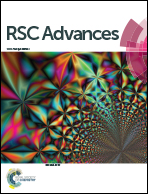Activation of persulfate by Co3O4 nanoparticles for orange G degradation†
Abstract
Nano-Co3O4 was prepared by a precipitation method and successfully applied as a heterogeneous catalyst to activate persulfate (PS). The heterogeneous character of PS activation with nano-Co3O4 was more pronounced at neutral pH as indicated by the maximum degradation rate of orange G (OG) and the low concentration of dissolved cobalt ions. The increasing dosages of nano-Co3O4 and PS, and the higher temperature rapidly promoted the degradation kinetics of OG. Sulfate radicals (SO4˙−) and hydroxyl radicals (·OH) were proved to be the primary oxidative species, although the intensity of DMPO-OH signals were much stronger than that of DMPO-SO4 due to the fast transformation from DMPO-SO4 to DMPO-OH. The catalyst presented an acceptable stability through using it in five consecutive runs. The degradation pathways of OG in nano-Co3O4/PS process were proposed for the first time based on LC-MS analysis. The effects of Cl−, NO3−, HCO3−, Co2+, Fe2+ and Mn2+ ions, which usually co-exist as water matrix chemicals with azo-dyes, on OG removal by nano-Co3O4/PS were examined intensively. The reactivity of potassium persulfate (PS), sodium persulfate (NaPS) and potassium peroxymonosulfate (PMS) in the presence of nano-Co3O4 followed the order of nano-Co3O4/PMS > nano-Co3O4/PS > nano-Co3O4/NaPS.


 Please wait while we load your content...
Please wait while we load your content...